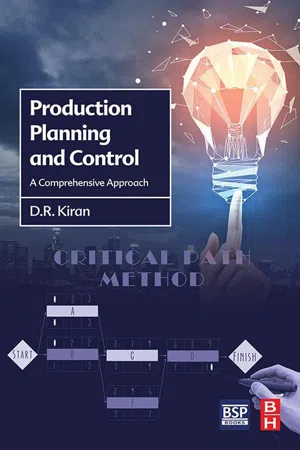
- 582 pages
- English
- ePUB (mobile friendly)
- Available on iOS & Android
About this book
Production Planning and Control draws on practitioner experiences on the shop floor, covering everything a manufacturing or industrial engineer needs to know on the topic. It provides basic knowledge on production functions that are essential for the effective use of PP&C techniques and tools. It is written in an approachable style, thus making it ideal for readers with limited knowledge of production planning. Comprehensive coverage includes quality management, lean management, factory planning, and how they relate to PP&C. End of chapter questions help readers ensure they have grasped the most important concepts.With its focus on actionable knowledge and broad coverage of essential reference material, this is the ideal PP&C resource to accompany work, research or study.- Uses practical examples from the industry to clearly illustrate the concepts presented- Provides a basic overview of statistics to accompany the introduction to forecasting- Covers the relevance of PP&C to key emerging themes in manufacturing technology, including the Industrial Internet of Things and Industry 4
Frequently asked questions
- Essential is ideal for learners and professionals who enjoy exploring a wide range of subjects. Access the Essential Library with 800,000+ trusted titles and best-sellers across business, personal growth, and the humanities. Includes unlimited reading time and Standard Read Aloud voice.
- Complete: Perfect for advanced learners and researchers needing full, unrestricted access. Unlock 1.4M+ books across hundreds of subjects, including academic and specialized titles. The Complete Plan also includes advanced features like Premium Read Aloud and Research Assistant.
Please note we cannot support devices running on iOS 13 and Android 7 or earlier. Learn more about using the app.
Information
Elements of production planning and control
Abstract
Keywords
- 1. Appreciate the role and scope of production planning and control in a successful organization.
- 2. Appreciate the specific planning and control principles to be applied for long-range and short-range plans.
- 3. Understand the factor contributing to the complexity of control so as to prepare for any exigencies
- 4. Relate the P–D–C–A cycle of quality control and the O–A–A–E cycle of production control.
- 5. Make further study of the references made at the end of the chapter.
1.1 Production planning and control
- 1. What production facilities are required?
- 2. How should these production facilities be laid out in the space available for production?
- 3. How they should they be used to produce the desired products at the desired rate of production?
1.2 Role and scope of production planning and control
- • The type and complexity of the PP&C techniques vary with the type and volume of production.
- • Factories producing large volumes of standardized products need very simple production control techniques.
- • Factories producing a variety of products and product mix also need meticulous control with complex production control techniques.
- • PP&C has to ensure that all the operations are done on all components without exception.
- • PP&C must balance the extent of meticulous control against the costs.
1.3 Objectives of production planning and control
- 1. Minimize the idle times of men and machines.
- 2. Minimize inventory turnover.
- 3. Maximize the percentage of the commitments given to the customers.
- 4. Maximize the product quality and customer satisfaction.
- 5. Keep inventory levels low.
- 6. Provide long runs and low setup times.
- 7. Minimize bottlenecks along the production flow.
- 8. Plan early indents to give enough lead time for the purchase of goods at optimal process.
1.4 Functions of production planning and control
- 1. Aid forecasting the future for scheduling purposes.
- 2. Aid cost estimation for new jobs.
- 3. Receive orders from the marketing department.
- 4. Translate the schedules into manpower requirements.
- 5. Decide on make or buy decisions.
- 6. Determine the material requirements.
- 7. Maintain the raw material requirement.
- 8. Determine the machinery requirements and their special attachments, if any.
- 9. Determine the operations to be performed and the sequence of operations.
- 10. Prepare operation process charts.
- 11. E...
Table of contents
- Cover image
- Title page
- Table of Contents
- Copyright
- About the author
- Preface
- Acknowledgments
- Abbreviations used in the book
- Useful computer software
- Chapter 1. Elements of production planning and control
- Chapter 2. Factory planning
- Chapter 3. Factors for production
- Chapter 4. Production system
- Chapter 5. The concept of productivity
- Chapter 6. Organization for production planning and control
- Chapter 7. Terminology used in Japanese management practices
- Chapter 8. Fundamentals of statistics—part I
- Chapter 9. Correlation and probability theory
- Chapter 10. Forecasting
- Chapter 11. Trend analysis in forecasting
- Chapter 12. Decision theory
- Chapter 13. Types of production situations
- Chapter 14. Break-even and make or buy analyses
- Chapter 15. Cost of production
- Chapter 16. Product and process development
- Chapter 17. Plant location
- Chapter 18. Plant layout
- Chapter 19. Systematic layout planning
- Chapter 20. Capacity planning
- Chapter 21. Aggregate planning
- Chapter 22. Routing, scheduling, and loading
- Chapter 23. Master production schedules
- Chapter 24. Sequencing and line balancing
- Chapter 25. Dispatching and expediting
- Chapter 26. Just in time and kanban
- Chapter 27. Systems and procedures
- Chapter 28. Theory of constraints
- Chapter 29. Scientific inventory control
- Chapter 30. Material requirement planning
- Chapter 31. Manufacturing resource planning (MRP II)
- Chapter 32. Critical path method
- Chapter 33. CIPMS—computer-integrated production management system
- Chapter 34. Industry 4.0
- Chapter 35. Internet of Things
- Summary of the university syllabi
- Bibliography
- Index